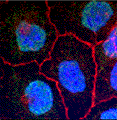Biochemistry, Department of
Document Type
Article
Date of this Version
1-12-2007
Abstract
Detoxification and homeostatic acquisition of metal ions are vital for all living organisms. We have identified PCA1 in yeast Saccharomyces cerevisiae as an overexpression suppressor of copper toxicity. PCA1 possesses signatures of a PIB-type heavy metal-transporting ATPase that is widely distributed from bacteria to humans. Copper resistance conferred by PCA1 is not dependent on catalytic activity, but it appears that a cysteine-rich region located in the N terminus sequesters copper. Unexpectedly, when compared with two independent natural isolates and an industrial S. cerevisiae strain, the PCA1 allele of the common laboratory strains we have examined possesses a missense mutation in a predicted ATP-binding residue conserved in PIB-type ATPases. Consistent with a previous report that identifies an equivalent mutation in a copper-transporting PIB-type ATPase of a Wilson disease patient, the PCA1 allele found in laboratory yeast strains is nonfunctional. Overexpression or deletion of the functional allele in yeast demonstrates that PCA1 is a cadmium efflux pump. Cadmium as well as copper and silver, but not other metals examined, dramatically increase PCA1 protein expression through post-transcriptional regulation and promote subcellular localization to the plasma membrane. Our study has revealed a novel metal detoxification mechanism in yeast mediated by a PIB-type ATPase that is unique in structure, substrate specificity, and mode of regulation.



Comments
Published in The Journal of Biological Chemistry 282:2 (January 12, 2007), pp. 947-955; doi 10.1074/jbc.M609535200 Copyright © 2007 by The American Society for Biochemistry and Molecular Biology, Inc. Used by permission.http://www.jbc.org